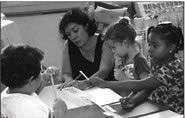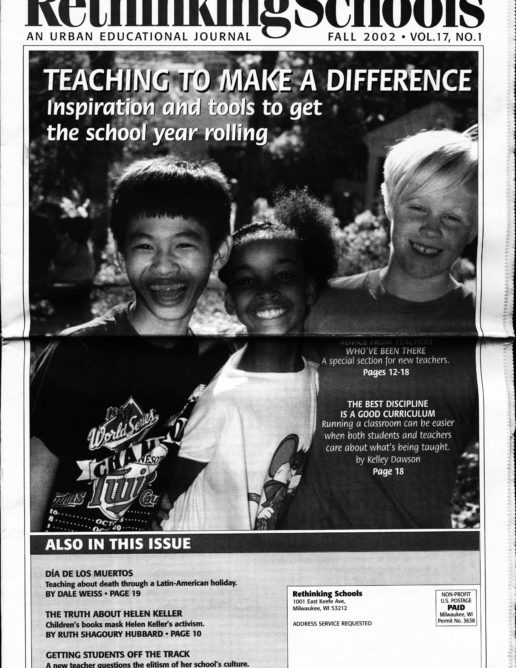‘Curriculum is Everything that Happens’
A veteran offers some advice to new teachers
Illustrator: Susan Ruggles

– photo: Susan Ruggles
Rita Tenorio has spent more than 25 years teaching children in the early elementary grades. Since 1988 she has taught at La Escuela Fratney, a public school in Milwaukee that she helped to found. Fratney features two-way bilingual education – all students learn in both English and Spanish – and a curriculum that emphasizes anti-racist, social-justice education. In this interview by Leon Lynn, she offers encouragement and guidance to those just starting out in the teaching profession.
Q: Do you think that the average person coming out of a teacher-education program in college is ready to be a teacher?
A: I would say this to them: You’ve spent a lot of time in school, you’ve had some teaching experiences, you’ve been able to accumulate a lot of information, and lots of it is probably very, very good. But there are also a whole bunch of other things, important things, that you may not know yet. You need to be open to that and ready to learn things.
Q: Like what?
A: Well to begin with, if you haven’t been around teachers who have a political consciousness, who have experience with the social and political effects of things that take place in the schools, you definitely have to learn about that. You can’t be thinking that your classroom is a safe little place that’s separated from the rest of the world. Schools are impacted by larger social forces, by the dynamics of who has power in our society, issues of race, how decisions are made. These forces determine so many things – whether schools are adequately funded or whether the students and their families are comfortable or struggling to make ends meet – things that affect what happens in the classroom.
I like to think that the people who have worked with us at Fratney have a sense of that, because we try to make it a real up-front issue. Fratney is built on the principles of antiracism and multiculturalism, the idea that we’re not just preparing students to take and pass tests, we’re not just preparing them academically but also to play a conscious and active role in society, to recognize and combat racism, to actively pursue social justice. These are things that many new teachers may not have been exposed to.
Q: What advice would you give to a new teacher who finds a job in a school where the students are from a culture the teacher doesn’t know well?
A: I think all teachers, especially new teachers, have to work very hard at getting to know who their students are. I don’t just mean learning what their favorite colors are, but understanding things about them and their families. When I was first teaching, I knew very little about African-American history and culture. My stereotypes were that the African-American children came from very poor families who didn’t have much education, and that they were city-bound kids. But then I began listening to the children, the stories they told, and I began to realize just how stereotyped and limited my understanding was. I remember hearing children talking about going camping with their families and realizing that I never would have imagined them doing that. That’s just one small example.
In college you learn how to teach different parts of the curriculum, how to teach math, how to teach social studies. It’s kind of assumed that the kids will come into the classroom and sit down, and you can take what you’ve learned about and just start teaching it and the kids will learn. And what really happens is very different from that. You need to assess where the kids are coming from. Find out what they know. What is their daily experience like? What language do they speak at home? What past experiences has the family had with schools and learning? And then you need to move them along from that place.
Q: How can the teacher start that process?
A: It’s the teacher’s job to invite the students to bring that information into the classroom, to tell stories about their families, to feel valued for making that contribution and for who they are. And we need to make sure this applies to all the children, not just the cute and verbal ones who are acclimated to the culture of school. That tends to happen a lot: There’s this picture in the teacher’s mind of the ideal kid and this notion that things would be better “if you could just be more like so-and-so.” And that’s so limiting, so unfair.
Kids are learning all the time, but they’re not necessarily learning the curriculum you think you’re teaching them. Curriculum is everything that happens. It’s not just books and lesson plans. It’s relationships, attitudes, feelings, interactions. If kids feel safe, if they feel inspired, if they feel motivated, if they feel capable and successful, they’re going to learn important and positive things. But if those elements are not there, if kids feel disrespected or neglected in school, they’re learning from that too.
Q: Teachers are under everincreasing pressure to “teach to the test,” to drill everyone on the same narrow band of curriculum and keep test scores up. And in many places there is increased support for very strict, scripted curriculum and teaching, such as Direct Instruction. How can a teacher do the kinds of things you are saying are crucial, while coping with these pressures?
A: It’s a paradox, to be sure. In college you learn all about multiple intelligences, and different ways and styles of learning, and then you start teaching and more often than not they hand you a curriculum and say, “This is how to do it.” And you can’t just walk away from that. But you have to try and find ways to go beyond what is being scripted. Maybe you have to follow a very narrow instructional model in reading, for example, but maybe there are ways you can integrate a broader vision of reading into other subjects, like science or math.
In my first-grade class we keep science and math journals, for example. We get the kids collecting data about what we’re doing with those subjects. They’re using the research process to investigate their world. We also get the kids involved in formulating questions to investigate, questions they might have about their families, about the teachers. And in their journals they are using reading and writing to reflect on the process and respond to what they’ve learned.
There’s another element too: You have to be part of a culture that stands up and asks, “Is this the best thing for our children?” There are schools where those questions are never asked. It’s up to teachers to play a role in changing that, in raising holy hell if necessary to advocate for the children.
Q: How can a new teacher, brand new in the building and the district, do that?
A: It may seem overwhelming for people who are newer in the profession, but in some ways I think it’s actually easier for them. I know I had a lot more energy for this stuff when I was younger. This is the time to ask questions. When you’re young and new, you can establish who you are and what your priorities are.
One thing that really helped me was getting together with a network of people, searching out people who felt the way I did, and staying connected with them. You want to find the people in your own building whom you feel you can communicate with, whom you can raise questions with. You want to start looking in your district: I found some terrific people in the teachers’ union and through some professional development activities. There are networks and groups that stretch all across the country that address some of these issues, like multiculturalism, and you can tap into those. If you have friends from the university, and other people you’ve known for a while, you stay connected with them. Find people in the community, people who aren’t teachers, who are interested in education issues. Get on the web and start hunting for good websites and listservs. Then it’s not just your voice out there in the wilderness. And together you can make good things happen.

